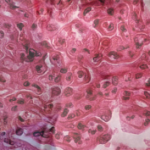BOSTON—For patients with lupus nephritis, multi-targeted therapies combining drugs similar to what oncologists do now to treat cancer is the future of treatment for this complication of lupus, according to Michelle Petri, MD, MPH, professor of medicine, director, Lupus Center, Johns Hopkins University School of Medicine, Baltimore, who emphasized the need for aggressive therapy to achieve a goal of complete response and remission.
Adding rituximab to the mix may permit reducing and avoiding altogether the use of long-term steroids if an international, multicenter trial just underway can demonstrate the efficacy and safety of a rituximab regimen sans steroids for lupus nephritis, according to Liz Lightstone, MD, professor of renal medicine, Imperial Lupus Centre, Imperial College London, Hammersmith Hospital, London, U.K.
These were among the issues discussed in a session titled, Forefronts in Lupus Nephritis, at the ACR/ARHP Annual Meeting in Boston in November 2014, in which Drs. Petri and Lightstone focused on the future of combination therapies that can both effectively treat lupus nephritis, as well as reduce side effects and improve quality of life in these patients.
Multi-Targeted Treatment Approach
For Dr. Petri, treatment of lupus nephritis requires an aggressive approach that includes a variety of treatments targeted at multiple issues. For acute treatment, she described a combination of multi-targeted therapies that she uses, including ACE/ARB to control blood pressure, protect renal function and, perhaps, reduce fibrosis; hydroxychloroquine, which when used with mycophenolate mofetil (MMF) improves complete renal response rates; and vitamin D, which shows a modest benefit on disease activity and urine protein/creatinine levels. Achieving a 25-hydroxy level of 40 or above significantly helps reduce protein/creatinine levels.
For pregnant women, she emphasized the need for continual treatment of lupus nephritis because data show that renal activity can worsen during and after pregnancy and recommended azathioprine and cyclosporine or tacrolimus, but never MMF.
She also emphasized limiting exposure to steroids, saying that she typically doesn’t give high doses of prednisone to patients with mild Class III or IV disease nor any prednisone to some patients with Class II disease. Although guidelines recommend prednisone in all patients with Class IV disease, she highlighted that data also show that prednisone increases the risk of cardiovascular events, and therefore, she emphasized that a high dose is not needed in all patients. She also suggested that oral steroids may not be necessary at all in patients with mild nephritis.
For maintenance therapy, she uses MMF on the basis of results of the ALMS maintenance trial that showed the superiority of MMF over azathioprine.1 She offered a number of hints for administering the drug so that patients can better tolerate it (see Table 1).
| Table 1: Hints for Using MMF as Maintenance Therapy for Lupus Nephritis |
|---|
| Begin at an effective dose of 1,000 mg twice daily for one month. If the urine protein is not improving after one month, she ups the dose to 1,500 mg twice a day. |
| Split dose to take half in the morning and half at night. Because patients often forget their evening dose, she recommends they use their smartphone or some other technique to remind them. |
| Recognize the different dosing requirements based on ethnicity. Caucasians and Asians usually require 2,000 mg per day and African Americans often require 3,000 mg per day. |
| Get trough levels for monitoring whether patients are medication adherent. |
